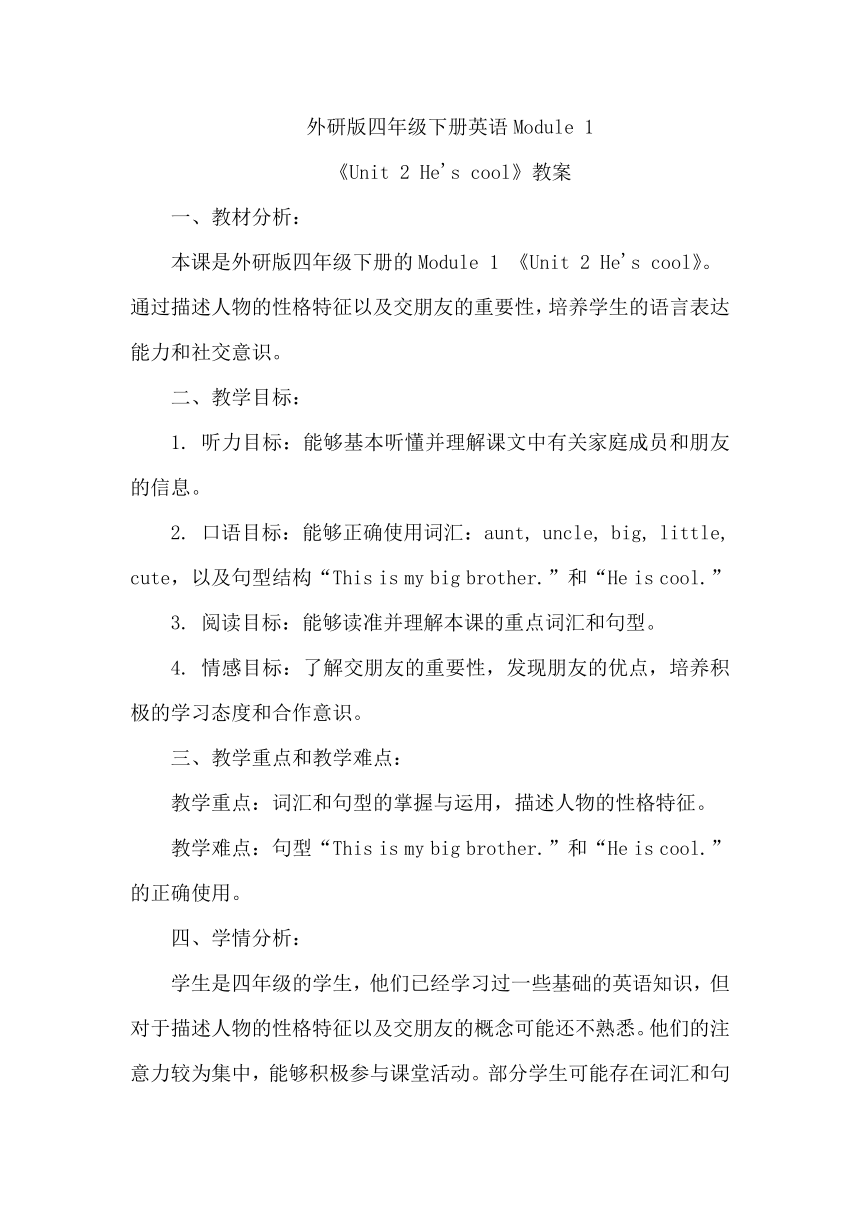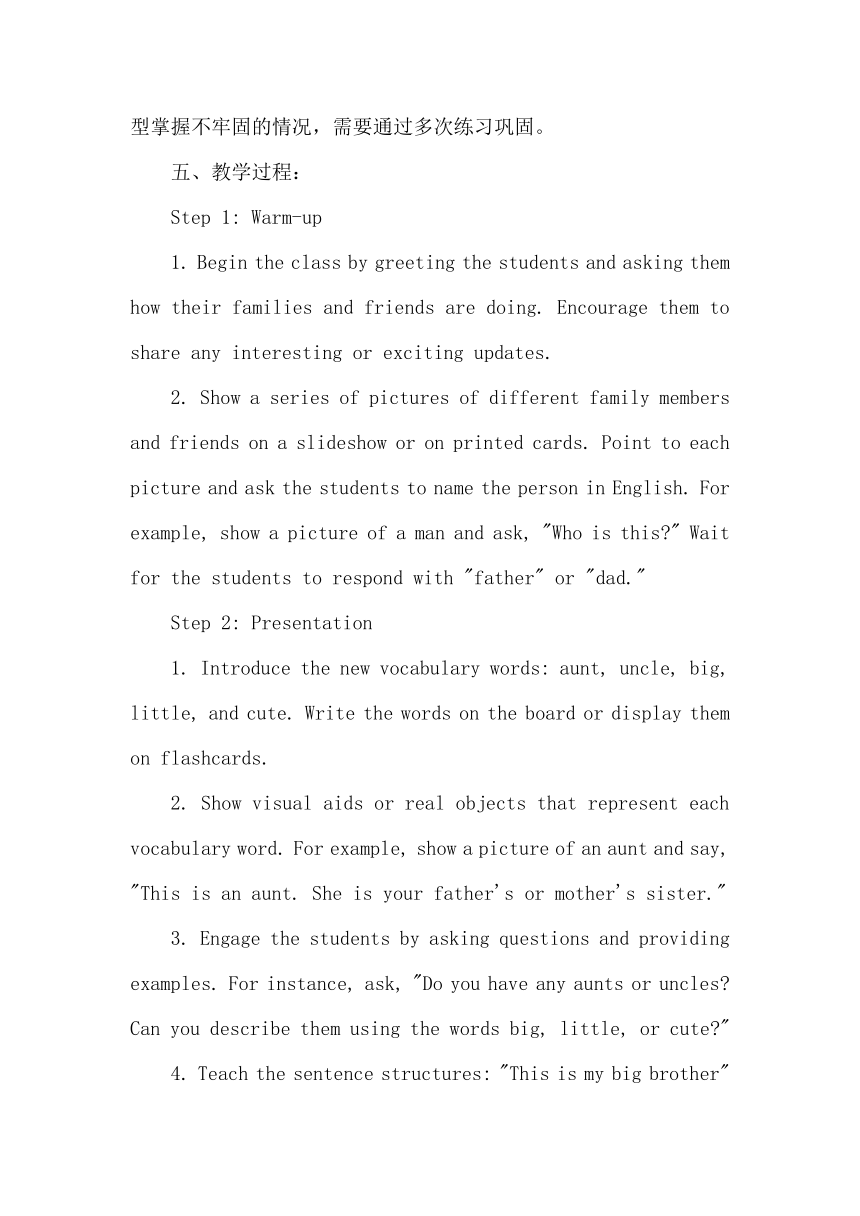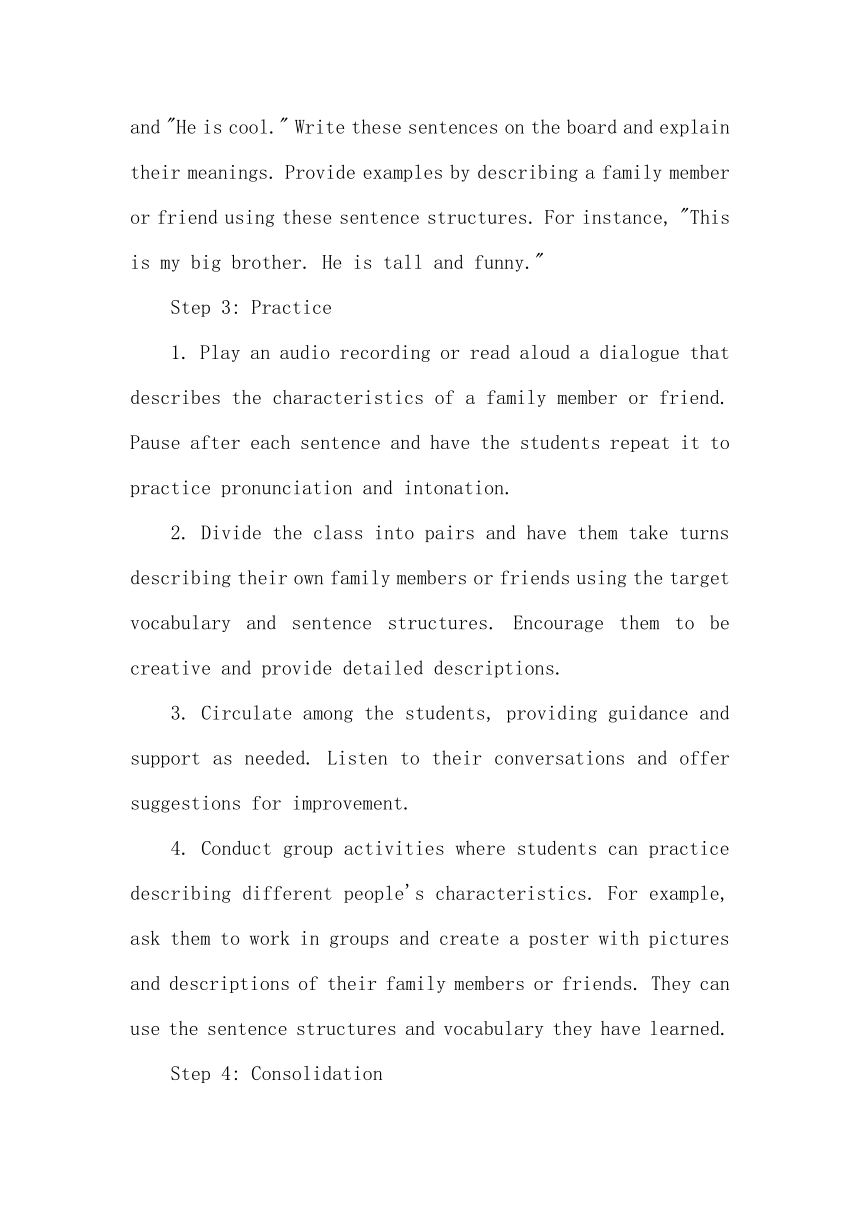Module 1 Unit 2 He's cool 教案(含反思)
文档属性
| 名称 | Module 1 Unit 2 He's cool 教案(含反思) |  | |
| 格式 | docx | ||
| 文件大小 | 13.7KB | ||
| 资源类型 | 教案 | ||
| 版本资源 | 外研版(三年级起点) | ||
| 科目 | 英语 | ||
| 更新时间 | 2024-02-17 10:15:20 | ||
图片预览



文档简介
外研版四年级下册英语Module 1
《Unit 2 He's cool》教案
一、教材分析:
本课是外研版四年级下册的Module 1 《Unit 2 He's cool》。通过描述人物的性格特征以及交朋友的重要性,培养学生的语言表达能力和社交意识。
二、教学目标:
1. 听力目标:能够基本听懂并理解课文中有关家庭成员和朋友的信息。
2. 口语目标:能够正确使用词汇:aunt, uncle, big, little, cute,以及句型结构“This is my big brother.”和“He is cool.”
3. 阅读目标:能够读准并理解本课的重点词汇和句型。
4. 情感目标:了解交朋友的重要性,发现朋友的优点,培养积极的学习态度和合作意识。
三、教学重点和教学难点:
教学重点:词汇和句型的掌握与运用,描述人物的性格特征。
教学难点:句型“This is my big brother.”和“He is cool.”的正确使用。
四、学情分析:
学生是四年级的学生,他们已经学习过一些基础的英语知识,但对于描述人物的性格特征以及交朋友的概念可能还不熟悉。他们的注意力较为集中,能够积极参与课堂活动。部分学生可能存在词汇和句型掌握不牢固的情况,需要通过多次练习巩固。
五、教学过程:
Step 1: Warm-up
1. Begin the class by greeting the students and asking them how their families and friends are doing. Encourage them to share any interesting or exciting updates.
2. Show a series of pictures of different family members and friends on a slideshow or on printed cards. Point to each picture and ask the students to name the person in English. For example, show a picture of a man and ask, "Who is this " Wait for the students to respond with "father" or "dad."
Step 2: Presentation
1. Introduce the new vocabulary words: aunt, uncle, big, little, and cute. Write the words on the board or display them on flashcards.
2. Show visual aids or real objects that represent each vocabulary word. For example, show a picture of an aunt and say, "This is an aunt. She is your father's or mother's sister."
3. Engage the students by asking questions and providing examples. For instance, ask, "Do you have any aunts or uncles Can you describe them using the words big, little, or cute "
4. Teach the sentence structures: "This is my big brother" and "He is cool." Write these sentences on the board and explain their meanings. Provide examples by describing a family member or friend using these sentence structures. For instance, "This is my big brother. He is tall and funny."
Step 3: Practice
1. Play an audio recording or read aloud a dialogue that describes the characteristics of a family member or friend. Pause after each sentence and have the students repeat it to practice pronunciation and intonation.
2. Divide the class into pairs and have them take turns describing their own family members or friends using the target vocabulary and sentence structures. Encourage them to be creative and provide detailed descriptions.
3. Circulate among the students, providing guidance and support as needed. Listen to their conversations and offer suggestions for improvement.
4. Conduct group activities where students can practice describing different people's characteristics. For example, ask them to work in groups and create a poster with pictures and descriptions of their family members or friends. They can use the sentence structures and vocabulary they have learned.
Step 4: Consolidation
1. Review the new vocabulary and sentence structures by playing interactive games. For example, play "Simon Says" using the vocabulary words and actions. Give commands like, "Simon says, 'Show me your big brother!'" The students should respond by pointing to a picture or raising their hand.
2. Have students take turns describing a family member or friend while the others guess who it is. Encourage the students to use the sentence structures and vocabulary they have learned. For example, a student may say, "This person is little and cute. They are my younger sister." The other students can try to guess the correct family member or friend.
Step 5: Wrap-up
1. Summarize the main points of the lesson by saying, "Today, we learned how to describe people's characteristics using words like big, little, and cute. We also learned how to introduce our family members and friends using sentences like 'This is my big brother' and 'He is cool.'"
2. Ask the students to share one thing they learned or enjoyed about the lesson. Encourage them to reflect on their progress and any challenges they overcame during the activities.
六、板书设计:
[Family Members and Friends]
aunt
uncle
big
little
cute
[Sentences]
This is my big brother.
He is cool.
七、教学反思:
本节课在教学过程中,通过多种方式引导学生掌握了描述人物特征的词汇和句型。学生们通过听、说、读、写的练习,逐渐熟悉了目标词汇和句型,并能够简单描述自己的家庭成员和朋友。在小组活动中,学生们积极参与,展示了合作和分享的精神。教师在教学过程中及时给予学生肯定和鼓励,提高了学生的自信心。然而,在巩固练习环节,可以加入更多的游戏和互动活动,以提高学生的参与度和学习兴趣。针对学生的差异化需求,可以为部分学生提供更多的支持和指导,例如给予更多的例句和模板,帮助他们更好地运用目标语言进行表达。同时,对于学习较快的学生,可以提供更多的拓展任务,让他们尝试用更多的形容词来描述人物的特征,以及进行更复杂的对话练习。本节课在教学目标的设定和教学过程的设计上较为合理,能够有效培养学生的语言表达能力和社交意识。通过不断的练习和巩固,学生们可以更好地掌握目标词汇和句型,并能够运用于实际交流中。
《Unit 2 He's cool》教案
一、教材分析:
本课是外研版四年级下册的Module 1 《Unit 2 He's cool》。通过描述人物的性格特征以及交朋友的重要性,培养学生的语言表达能力和社交意识。
二、教学目标:
1. 听力目标:能够基本听懂并理解课文中有关家庭成员和朋友的信息。
2. 口语目标:能够正确使用词汇:aunt, uncle, big, little, cute,以及句型结构“This is my big brother.”和“He is cool.”
3. 阅读目标:能够读准并理解本课的重点词汇和句型。
4. 情感目标:了解交朋友的重要性,发现朋友的优点,培养积极的学习态度和合作意识。
三、教学重点和教学难点:
教学重点:词汇和句型的掌握与运用,描述人物的性格特征。
教学难点:句型“This is my big brother.”和“He is cool.”的正确使用。
四、学情分析:
学生是四年级的学生,他们已经学习过一些基础的英语知识,但对于描述人物的性格特征以及交朋友的概念可能还不熟悉。他们的注意力较为集中,能够积极参与课堂活动。部分学生可能存在词汇和句型掌握不牢固的情况,需要通过多次练习巩固。
五、教学过程:
Step 1: Warm-up
1. Begin the class by greeting the students and asking them how their families and friends are doing. Encourage them to share any interesting or exciting updates.
2. Show a series of pictures of different family members and friends on a slideshow or on printed cards. Point to each picture and ask the students to name the person in English. For example, show a picture of a man and ask, "Who is this " Wait for the students to respond with "father" or "dad."
Step 2: Presentation
1. Introduce the new vocabulary words: aunt, uncle, big, little, and cute. Write the words on the board or display them on flashcards.
2. Show visual aids or real objects that represent each vocabulary word. For example, show a picture of an aunt and say, "This is an aunt. She is your father's or mother's sister."
3. Engage the students by asking questions and providing examples. For instance, ask, "Do you have any aunts or uncles Can you describe them using the words big, little, or cute "
4. Teach the sentence structures: "This is my big brother" and "He is cool." Write these sentences on the board and explain their meanings. Provide examples by describing a family member or friend using these sentence structures. For instance, "This is my big brother. He is tall and funny."
Step 3: Practice
1. Play an audio recording or read aloud a dialogue that describes the characteristics of a family member or friend. Pause after each sentence and have the students repeat it to practice pronunciation and intonation.
2. Divide the class into pairs and have them take turns describing their own family members or friends using the target vocabulary and sentence structures. Encourage them to be creative and provide detailed descriptions.
3. Circulate among the students, providing guidance and support as needed. Listen to their conversations and offer suggestions for improvement.
4. Conduct group activities where students can practice describing different people's characteristics. For example, ask them to work in groups and create a poster with pictures and descriptions of their family members or friends. They can use the sentence structures and vocabulary they have learned.
Step 4: Consolidation
1. Review the new vocabulary and sentence structures by playing interactive games. For example, play "Simon Says" using the vocabulary words and actions. Give commands like, "Simon says, 'Show me your big brother!'" The students should respond by pointing to a picture or raising their hand.
2. Have students take turns describing a family member or friend while the others guess who it is. Encourage the students to use the sentence structures and vocabulary they have learned. For example, a student may say, "This person is little and cute. They are my younger sister." The other students can try to guess the correct family member or friend.
Step 5: Wrap-up
1. Summarize the main points of the lesson by saying, "Today, we learned how to describe people's characteristics using words like big, little, and cute. We also learned how to introduce our family members and friends using sentences like 'This is my big brother' and 'He is cool.'"
2. Ask the students to share one thing they learned or enjoyed about the lesson. Encourage them to reflect on their progress and any challenges they overcame during the activities.
六、板书设计:
[Family Members and Friends]
aunt
uncle
big
little
cute
[Sentences]
This is my big brother.
He is cool.
七、教学反思:
本节课在教学过程中,通过多种方式引导学生掌握了描述人物特征的词汇和句型。学生们通过听、说、读、写的练习,逐渐熟悉了目标词汇和句型,并能够简单描述自己的家庭成员和朋友。在小组活动中,学生们积极参与,展示了合作和分享的精神。教师在教学过程中及时给予学生肯定和鼓励,提高了学生的自信心。然而,在巩固练习环节,可以加入更多的游戏和互动活动,以提高学生的参与度和学习兴趣。针对学生的差异化需求,可以为部分学生提供更多的支持和指导,例如给予更多的例句和模板,帮助他们更好地运用目标语言进行表达。同时,对于学习较快的学生,可以提供更多的拓展任务,让他们尝试用更多的形容词来描述人物的特征,以及进行更复杂的对话练习。本节课在教学目标的设定和教学过程的设计上较为合理,能够有效培养学生的语言表达能力和社交意识。通过不断的练习和巩固,学生们可以更好地掌握目标词汇和句型,并能够运用于实际交流中。
同课章节目录
- Module 1
- Unit 1 She's a nice teache
- Unit 2 He's cool.
- Module 2
- Unit 1 London is a big city.
- Unit 2 It's very old.
- Module 3
- Unit 1 Robots will do everything.
- Unit 2 On Monday I'll go swimming.
- Module 4
- Unit 1 Will you take your kite?
- Unit 2 Will it be hot in Haikou?
- Module 5
- Unit 1 I was two then.
- Unit 2 They were young.
- Module 6
- Unit 1 Were you at home yesterday?
- Unit 2 Was it a big city then ?
- Module 7
- Unit 1 I helped Mum.
- Unit 2 Grandma cooked fish.
- Module 8
- Unit 1 They sang beautifully.
- Unit 2 I took some pictures.
- Module 9
- Unit 1 Did he live in New York ?
- Unit 2 Did you have a nice holiday?
- Review Module
- Unit 1
- Unit 2
- Module 10
- Unit 1 Did you fall off your bike?
- Unit 2 Sam had lots of chocolate.
